
Those who conjure of conceivably terraforming Mars for mortal habitation have placed a lot of stopgap on the Red Planet presently containing water, as it would advance validity to the proposition that it could continue to retain water (and an atmosphere) under the right conditions. Still, a new study from experimenters at both the University of Texas and University Grenoble Alpes, published by Geophysical Research Letters in AGU Journals (American Geophysical Union), suggests that what scientists allowed was water may not actually be, well, water.
NASA
The platoon’s thesis is that the discovery of an extremely bright radar return1.4 km below the ice at the base of the south polar cap, which was long study to be an index of underground lakes or an aquifer, is actually being caused by commodity like stormy accoutrements. In other words, the platoon believes that commodity like a cluster of stormy gemstone could be responsible for these radar readings rather than an underground water source Experimenters used some of the roughly 15 times’ worth of measures handed by MARSIS (the Mars Advanced Radar for Subsurface and Ionosphere Sounding) to examine the reflectivity of Mars’ face and compare readings from colorful accoutrements to what was theorized to be an underground water source.
The study details
Propositions of water on Mars have been looking kindly tenuous for a while now, with several other propositions offering up more presumptive (but less instigative) explanations. As the study itself acknowledges, “ the current temperature and pressure at the Red Planet makes stable liquid water doubtful at the face.” While therefore far it’s not insolvable for Mars to contain water below the face, it’s not looking veritably probably As the study states in its conclusion, the readings between the accoutrements on the earth’s face and whatever it’s that MARSIS detected under the face of the south pole appear to be veritably analogous. To the point where it’s likely that they are, in fact, the same Our results give perceptivity into what current terrains being at the face of Mars could be responsible for the SPLD bright rudimentary reflections,” the study explains, “ Utmost of those bright regions are services of larger units geologically related to stormy constructs.”
This does n’t mean the hunt for water on Mars is over, still. According to the University of Texas, Cyril Grima, the study’s corresponding author and scientist for the University of Texas Institute for Geophysics (UTIG), is working with Isaac Smith, a Mars geophysicist from York University, to propose unborn water- chancing operations using radar. Presumably to find further substantiation of former life on the earth, or to help pick out implicit future wharf spots on the face.









